Mission: Impact podcast & blog
Build a better world without becoming a martyr to your nonprofit cause
Listen on:
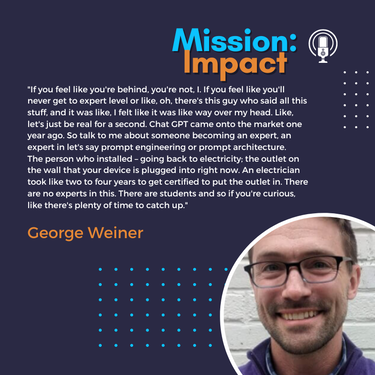 In episode 91 of Mission: Impact, Carol Hamilton and George Weiner discuss the intersection of artificial intelligence (AI) and the nonprofit sector. They delve into the significance of AI in the sector, emphasizing the need for strategic adoption and policy development. The conversation then shifts to the integration of AI into everyday tools They cover practical applications of AI and discuss crafting AI policies as well as the potential for AI to enhance nonprofit operations, particularly in grant writing and reporting. Episode highlights: [00:06:00] AI Adoption and Policy in Nonprofits [00:08:00] Hype Cycle of AI: [00:11:00] - AI in Everyday Life: [00:13:00] - AI for Nonprofit Content Creation [00:15:00] Crafting Nonprofit AI Policies and Guidelines [00:16:00] - Integrating AI in Nonprofits: [00:20:00] - Avoiding Overextension with AI: [00:24:00] - Practical AI Tools for Nonprofits: [00:27:00] Time Saving vs. Time Reallocation with AI [00:29:00] AI in Grant Writing: Guest Bio:
George Weiner is the Chief Whaler, WholeWhale.com. He co-founded CTOs For Good, PowerPoetry.org. He is a Dad, and a nonprofit geek. Important Links and Resources: WholeWhale.com George Weiner Cause Writer AI https://causewriter.ai/ The Smart Nonprofit by Beth Kanter and Allison Fine Click "Read More" for Transcript 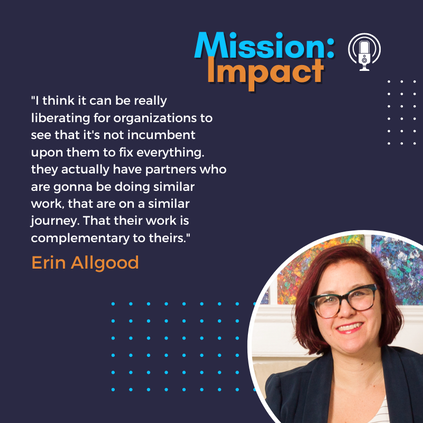 In episode 76 of Mission: Impact, Carol Hamilton and Erin Allgood discuss
Guest Bio: Erin Allgood helps organizations and individuals who give a damn create real impact. As the founder of Allgood Strategies, Erin helps socially-conscious organizations with strategic planning, organizational development, and leadership coaching. Her services focus on catalyzing social change at the systems, organizational, and individual levels. Important Links and Resources:
Click "Read More" for Transcript: 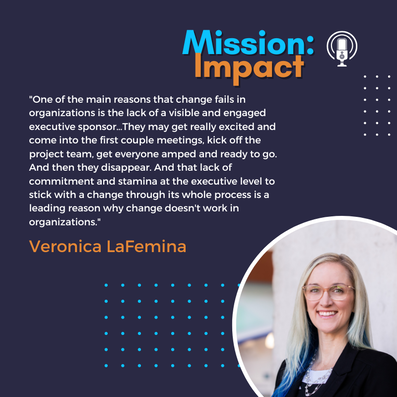 In episode 74 of Mission: Impact, Carol Hamilton and her guest, Veronica LaFemina discuss
Guest Bio: Veronica LaFemina is Founder and CEO of LaFemina & Co., an advisory firm supporting nonprofits and social impact businesses at the intersection of strategy, culture, communications, and change management. Veronica partners with organizations and their leaders to go beyond what “looks good on paper” to focus on what works well in real life. She is a leader, strategist, facilitator, trusted advisor, and certified change management professional with nearly two decades of experience as a senior executive at national U.S. nonprofit organizations and a high-impact consultant. Her work has been featured by Inc. Magazine, the Today Show, NPR, CNN, Capterra, and in news outlets nationwide. Important Links and Resources:
Click "Read More" for Transcript: 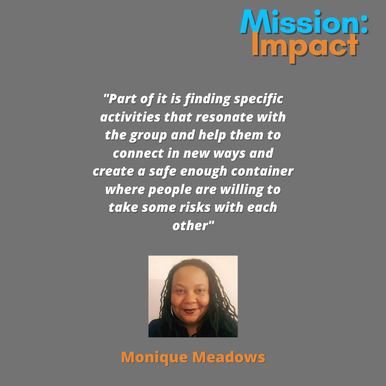 In episode 40 of Mission: Impact, Carol and her guests, Monique Meadows and Terrill Thompson, discuss:
Guest bio: Monique and Terrill are long-time friends and co-owners of Banyan Coaching and Consulting, where they partner with clients to create healthy, vibrant, and sustainable cultures through holistic coaching and facilitation. Our love for the natural world is integrated into all that we do. We invite you to tap into your inner knowing as we together transform and expand in ways that are electrifying, unpredictable and imperative. Monique is a lifelong student of energy healing, channeling and a Reiki Master. Terrill lives in a community on a permaculture farm where they draw energy and joy from producing food, nurturing healthy ecosystems, and offering respite to activists, artists, and organizational leaders. Both earned Master’s degrees in Organization Development from American University, where they were awarded Segal-Seashore Fellowships for their commitment to social justice. Important Links and Resources:
Click "Read More" for Transcript: 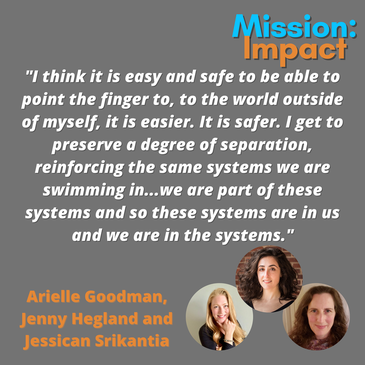 This week we’re talking to Arielle Goodman, Jenny Hegland and Jessica Srikantia. We talked about:
Resources mentioned: Otto Schwarmer and the MIT Presencing Institute www.ottoscharmer.com/ www.presencing.org/ Thomas Huebl thomashuebl.com/ Arielle, Jenny and Jessica are a team of colleagues that has been working together for the past six months to discover how they might be of service as a collective. Their work exists in cultivating the spaces between, such as in-between people during times of transition and not knowing, spaces within our own selves, or the connective tissue of complex systems. Together, they explore what is possible in and from wholeness. They are committed to transforming themselves into alignment with life, so that they can support this work in the broader world inclusive of and beyond their individual selves. Their areas of expertise include navigating uncharted terrain in times of uncertainty, helping systems see and sense themselves, and practicing sacred relationships with team and stakeholder groups. Links: www.linkedin.com/in/jennyhegland www.linkedin.com/in/jessica-srikantia-206797173/ www.linkedin.com/in/ariellegoodman/ Click "Read More" for Transcript: |
Archives
April 2024

Grace Social Sector Consulting, LLC, owns the copyright in and to all content in and transcripts of the Mission: Impact podcast, as well as the Mission: Impact blog with all rights reserved, including right of publicity.
|
Telephone301-857-9335
|
info[at]gracesocialsector.com
|
Grace Social Sector Consulting, LLC, owns the copyright in and to all content in, including transcripts and audio of the Mission: Impact podcast and all content on this website, with all rights reserved, including right of publicity.
|